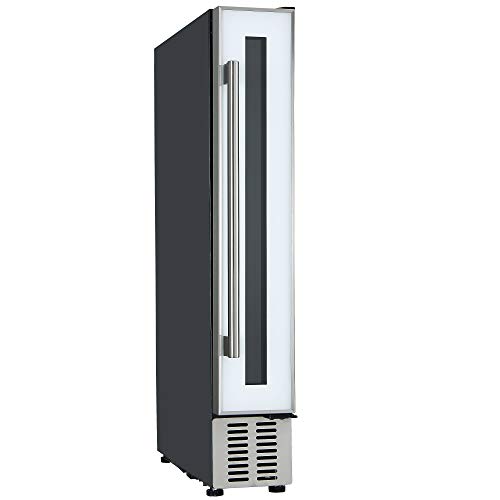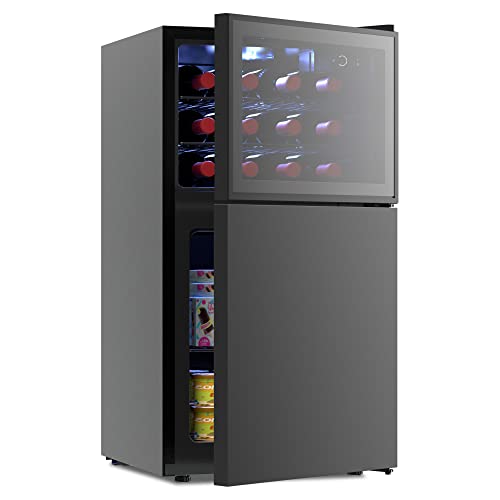What You Should Be Focusing On Enhancing Wine Fridge
페이지 정보

본문
 The Importance of a Wine Fridge
The Importance of a Wine Fridge If you're a serious collector or simply enjoy a glass with friends wine fridges can be a cost-effective solution that will help you maintain your collection over time.
If you're a serious collector or simply enjoy a glass with friends wine fridges can be a cost-effective solution that will help you maintain your collection over time.In contrast to traditional compressor-based refrigeration systems, thermoelectric wine refrigerators are based on the Peltier effect, in which electricity is transferred between two distinct junctions, creating a cooling effect.
Controlling Temperature
To ensure the quality of fine wine It is crucial to ensure that the temperature is at a perfect level. Unlike standard fridges, which maintain temperatures in the broad range, wine refrigerators are designed to meet the specific requirements of various varieties by maintaining temperatures in an encapsulated range. This allows for an ideal maturation of a wine, turning it from a regular bottle into something unique with time.
A wine fridge's ability to create the perfect climate for wine is a result of the carefully interaction between a variety of key features and technology. The most important aspect is the internal cooling system. It is comprised of a powerful thermoelectric Peltier module and an energy sink. The side of the Peltier module that absorbs heat lowers the internal temperature, whereas the other side releases the heat that is absorbed making it a perfect cool environment for wine.
In addition to temperature, wine refrigerators come with a precise humidity control system. This feature is crucial to prevent cork deterioration. Wine fridges have a relative humidty between 50% and 80%. This is the perfect balance to stop dry corks from breaking and allowing air to enter the fridge, resulting in spoilage.
Another factor that contributes to constant temperature control is the wine fridge's internal ventilation system. The fridges are usually fitted with an efficient fan that circulates air throughout the entire cabinet, eliminating pockets of warm or humid air. This ensures that every bottle receives the same amount of cool air no matter where it is located in the fridge.
The cooling system is designed to minimize vibrations that can disrupt temperature distribution and cause fluctuations. To keep the vibrations to the minimum, it's recommended to limit the number of times you open and close the refrigerator door. Also, make sure that the bottles you place in your refrigerator don't hinder the ventilation or interfere with the fan.
A wine fridge's controlled atmosphere is crucial not just for storing wine but also for other delicate food items like cheeses and charcuterie. They allow these artisanal delights to retain their intended flavors and textures, ready for you to enjoy at any moment. Certain herbal and medicinal supplements are also benefited by being kept in a controlled and cool environment to increase their effectiveness and potency.
Maintaining Humidity
It is often overlooked when it comes to wine storage, humidity is an essential element that can be easily managed. Humidity can have an immediate influence on the quality of wine, and is especially important for long-term storage. It is recommended that wine be stored in an environment in which the relative humidity (RH) is constant between 50-70%. Humidity control is vital to safeguard your collection from damage while maintaining the ideal wine conditions for maturation.
The humidity can affect the delicate balance of aromatic elements that contribute to the wine's flavor profile. The composition of these compounds can alter the taste profile of wine and can lead to loss of flavor.
A hygrometer is a great way to regulate the humidity inside your wine refrigerator. These devices are fairly inexpensive and can assist you in creating the ideal environment for your wine storage.
If you purchase an expensive wine fridge, you will also be able to benefit from integrated humidity control systems that regulate and monitor humidity levels automatically, which ensures optimal conditions for your wine. The control of humidity helps to prevent corks from drying out and swelling, which can let air in the bottle and cause spoilage to the wine. It also prevents oxidation and ensures that labels are legible. This helps preserve the integrity of your wine and increases its value.
You can also increase the humidity of your wine refrigerator by placing a container of water inside. The water will slowly evaporate and increase the humidity levels. Another option is to use baking soda, which is known for its moisture-absorbing properties. Place open baking soda containers strategically inside your wine rack refrigerator fridge, and replace them periodically to maintain their effectiveness. You can also invest in an absorber for moisture that consists of a series of trays containing mineral salts known to naturally absorb excess water from the air. This will not only help to maintain wine temperatures however, it will also shield against the growth of mold and other contaminants.
Redefining Aging Potential
Proper wine storage requires more than a spot in the fridge. It is important to keep wine in the most optimal conditions to preserve its potential for maturing. Contrary to conventional refrigerators that are designed to keep food cold wine refrigerators are designed to ensure optimal temperatures and humidity levels. This safeguards your investment by shielding each bottle from premature oxidation and damage to the cork.
Wine fridges are self-contained units that allow for easy operation out of the box. The most basic models have only one temperature setting which can be adjusted manually and more sophisticated dual-zone wine fridges allow you to store both red and white wines at different temperatures. Internal fans ensure all bottles receive the equal amount of airflow. They also prevent pockets of warm or humid air from creating. This ensures that all bottles receive the same cooling level which allows them to achieve their full potential to age.
The Peltier effect is used to cool thermoelectric wine refrigerators. A Peltier module operates by transferring an electric current between two pieces of metal that are connected. It absorbs heat from one side and expel it from the other. This process does not produce refrigerant, making it an ideal alternative to compressor-based wine coolers which use hydrofluorocarbon gases. Thermoelectric wine coolers are recognized for their energy efficiency, as they use less electricity to provide the same cooling effects as compressor units.
It's important to consider the length of storage time when choosing a wine fridge for kitchen fridge. For long-term storage, a temperature range of 50degF and 55degF, or 10degC and 12 degC is vital to preserve the phenolic compounds that enhance the wine's aroma, flavor, and mouthfeel. Storage of wine for short-term storage however, requires a slightly warmer temperature of between 55degF and 60degF or 12degC to prevent premature oxidation and preserve the fruit flavors.
The lighting system in the wine refrigerator is designed to minimize exposure to UV rays. These rays are able to quickly destroy wine's aromatic compounds as well as color. Thermoelectric wine fridges as well as many models that are compressor-based today have UV-resistant glass or doors to help shield your wine from harmful rays. Some wine chiller under counter refrigerators also have vibration reduction mechanisms to reduce disturbances. This creates a calm environment for storing old bottles.
How do you prolong the life of cork?
A wine refrigerator is not just a convenient solution to store your wine but also a security device. A wine fridge protects your bottles from changes in temperature, humidity loss and vibration disturbances, regardless of whether you are storing them for short-term use or long-term maturation.
Consistent temperatures reduce the amount of oxygen that seeps into corks, causing the wine to spoil. This stops oxidation, which could cause wine to lose its vibrancy and create off flavors. Wine fridges maintain the ideal humidity level to stop corks from shrinking, which can allow air to get into bottles and losing their vibrancy.
This allows the corks' swell and form an airtight seal that is essential for long-term ageing. The majority of wine refrigerators are equipped with thermoelectric or compressor cooling systems, which means you can choose the best option for your collection.
The dark interior of a wine refrigerator protects your bottles from excessive UV light. UV rays can damage the volatile compounds in your Wine Refrigerator tall decreasing the quality of your compact wine fridge and speeding up aging. Moreover the dark interiors of wine fridges protect your wine from other household odors which could alter the taste and aroma. While a small amount of baking soda may be able to absorb some of these odors, a wine fridge is equipped with built in wine refrigerator-in odour control systems that ensure your wines are always ready to serve.
Most importantly, wine refrigerators minimize vibration disturbance that can agitate your wines that have been sitting for a while or affect the cork's strength and tightness. This is particularly important since fridges that are used in the kitchen can also store food, including leftovers with strong aromas that can seep in and overwhelm the natural flavours of your expensive bottles of cabernet. Some wine fridges also have neutralization technology to eliminate smelly residue and odours from paint, cleaning products and other chemicals that are found in your refrigerator.
- 이전글Ultimate Guide to Gambling Site 24.08.27
- 다음글A Provocative Rant About Compact 3 Wheel Stroller 24.08.27
댓글목록
등록된 댓글이 없습니다.

